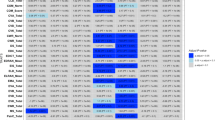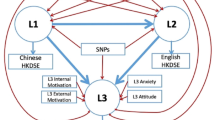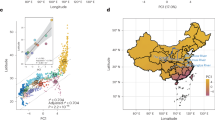Abstract
As the world’s most populous nation, China exhibits a population with 56 nationalities. We already know the associations between genetic relationship of these ethnic groups in China and their geographic distributions are closely. However, the correlations between genetic diversity and linguistic affinities have still not been fully revealed in China. To investigate these correlations, 31 populations and 1527 samples were chosen, and the languages of this population covered all of the languages spoken in mainland China (including 8 main linguistic families and 16 subfamilies). The genetic polymorphisms of the populations were investigated using 10 autosomal microsatellites. Five ethnic groups, which included 234 samples, were genotyped in this survey, and the data collected from the other 26 populations were obtained from our previous study. An analysis of molecular variance, principal coordinate analysis, clustering analysis using the STRUCTURE and the Mantel test were used to investigate the correlations between genetic diversity and linguistic affinity. These analyses indicated that most populations who speak the same language demonstrate a similar genetic composition, although a few populations deviated from this linkage between genetics and language. The demographic histories of these populations who deviated from this linkage were investigated. Obvious reasons for why evolutionary processes of genetics and linguistics separated in these populations included geographic isolation, gene replacement, language replacement and intermarriage. Thus, we proposed that the consistency of genetic and linguistic evolution is still present in most populations in China; however, this consistency can be broken by many factors, such as isolation, language replacement or intermarriage.
Similar content being viewed by others
Log in or create a free account to read this content
Gain free access to this article, as well as selected content from this journal and more on nature.com
or
References
Chu, J. Y., Huang, W., Kuang, S. Q., Wang, J. M., Xu, J. J., Chu, Z. T. et al. Genetic relationship of populations in China. Proc. Natl Acad. Sci. USA 95, 11763–11768 (1998).
Di, D. & Sanchez-Mazas, A. Challenging views on the peopling history of East Asia: the story according to HLA markers. Am. J. Phys. Anthropol. 145, 81–96 (2011).
Wen, B., Li, H., Lu, D., Song, X., Zhang, F., He, Y. et al. Genetic evidence supports demic diffusion of Han culture. Nature 431, 302–305 (2004).
Abdulla, M. A., Ahmed, I., Assawamakin, A., Bhak, J., Brahmachari, S. K., Calacal, G. C. et al. Mapping human genetic diversity in Asia. Science 326, 1541–1545 (2009).
Sun, H., Zhou, C., Huang, X. Q., Lin, K. Q., Shi, L., Yu, L. et al. Autosomal STRs provide genetic evidence for the hypothesis that Tai People originate from Southern China. PLoS One 8, e60822 (2013).
Yao, Y. G., Nie, L., Harpending, H., Fu, Y. X., Yuan, Z. G. & Zhang, Y. P. Genetic relationship of Chinese ethnic populations revealed by mtDNA sequence diversity. Am. J. Phys. Anthropol. 118, 63–76 (2002).
Manica, A., Prugnolle, F. & Balloux, F. Geography is a better determinant of human genetic differentiation than ethnicity. Hum. Genet. 118, 366–371 (2005).
Lin, H., Fan, H., Zhang, F., Huang, X., Lin, K., Shi, L. et al. Genetic relationships of ethnic minorities in Southwest China revealed by microsatellite markers. PLoS One 5, e9895 (2010).
Nei, M. & Takezaki, N. The root of the phylogenetic tree of human populations. Mol. Biol. Evol. 13, 170–177 (1996).
Wright, S. Evolution and the Genetics of Populations; a Treatise (University of Chicago Press: Chicago, Illinois, USA, 1968).
Cavalli-Sforza, L. L. The Chinese human genome diversity project. Proc. Natl Acad. Sci. USA 95, 11501–11503 (1998).
Excoffier, L., Laval, G. & Schneider, S. Arlequin (version 3.0): an integrated software package for population genetics data analysis. Evol. Bioinform. Online. 1, 47–50 (2005).
Nei, M. Molecular Evolutionary Genetics (Columbia University Press: New York, NY, USA, 1987)).
Wright, S. Evolution and the Genetics of Populations, Volume 4 (University of Chicago Press: Chicago, IL, USA, 1984).
Peakall, R. O. D. & Smouse, P. E. Genalex 6: genetic analysis in Excel. Population genetic software for teaching and research. Mol. Ecol. Notes 6, 288–295 (2006).
Excoffier, L., Smouse, P. E. & Quattro, J. M. Analysis of molecular variance inferred from metric distances among DNA haplotypes: application to human mitochondrial DNA restriction data. Genetics 131, 479–491 (1992).
Smouse, P. E., Long, J. C. & Sokal, R. R. Multiple regression and correlation extensions of the Mantel test of matrix correspondence. Syst. Biol. 35, 627 (1986).
Smouse, P. E. & Long, J. C. Matrix correlation analysis in anthropology and genetics. Am. J. Phys. Anthropol. 35, 187–213 (1992).
Slatkin, M. A measure of population subdivision based on microsatellite allele frequencies. Genetics 139, 457–462 (1995).
Sinnott, R. W. Virtues of the Haversine. Sky. Telescope 68, 158–159 (1982).
Sagart, L., Blench, R. & Sanchez-Mazas, A. The Peopling of East Asia: Putting Together Archaeology, Linguistics and Genetics (RoutledgeCurzon: London, UK, 2005).
Gordon, R. G. & Grimes, B. F. Ethnologue: Languages of the World (SIL International: Dallas, TX, USA, 2005).
Pritchard, J. K., Stephens, M. & Donnelly, P. Inference of population structure using multilocus genotype data. Genetics 155, 945–959 (2000).
Falush, D., Stephens, M. & Pritchard, J. K. Inference of population structure using multilocus genotype data: dominant markers and null alleles. Mol. Ecol. Notes 7, 574–578 (2007).
Falush, D., Stephens, M. & Pritchard, J. K. Inference of population structure using multilocus genotype data: linked loci and correlated allele frequencies. Genetics 164, 1567–1587 (2003).
Hubisz, M. J., Falush, D., Stephens, M. & Pritchard, J. K. Inferring weak population structure with the assistance of sample group information. Mol. Ecol. Resour. 9, 1322–1332 (2009).
Rosenberg, N. A. DISTRUCT: a program for the graphical display of population structure. Mol. Ecol. Notes 4, 137–138 (2004).
Karafet, T., Xu, L., Du, R., Wang, W., Feng, S., Wells, R. S. et al. Paternal population history of East Asia: sources, patterns, and microevolutionary processes. Am. J. Hum. Genet. 69, 615–628 (2001).
Hedrick, P. W. Perspective: highly variable loci and their interpretation in evolution and conservation. Evolution. 53, 313–318 (1999).
Ding, Y. C., Wooding, S., Harpending, H. C., Chi, H. C., Li, H. P., Fu, Y. X. et al. Population structure and history in East Asia. Proc. Natl Acad. Sci. USA 97, 14003–14006 (2000).
Cavalli-Sforza, L. L. Genes, peoples, and languages. Proc. Natl Acad. Sci. USA 94, 7719 (1997).
Kutanan, W., Kampuansai, J., Colonna, V., Nakbunlung, S., Lertvicha, P., Seielstad, M. et al. Genetic affinity and admixture of northern Thai people along their migration route in northern Thailand: evidence from autosomal STR loci. J. Hum. Genet. 56, 130–137 (2011).
Kutanan, W., Kampuansai, J., Fuselli, S., Nakbunlung, S., Seielstad, M., Bertorelle, G. et al. Genetic structure of the Mon-Khmer speaking groups and their affinity to the neighbouring Tai populations in Northern Thailand. BMC. Genet. 12, 56 (2011).
Su, B., Xiao, J., Underhill, P., Deka, R., Zhang, W., Akey, J. et al. Y-chromosome evidence for a northward migration of modern humans into Eastern Asia during the Last Ice Age. Am. J. Hum. Genet. 65, 1718–1724 (1999).
Wen, B., Li, H., Gao, S., Mao, X., Gao, Y., Li, F. et al. Genetic structure of Hmong-Mien speaking populations in East Asia as revealed by mtDNA lineages. Mol. Biol. Evol. 22, 725–734 (2005).
Chen, L. Zhongguo Minzushi Gangyao (The Compendium of Chinese Nationality Histories) (China Financial & Economic Press: Beijing, China, 1999).
Ma, Y. China's Minority Nationalities (Foreign Languages Press: Beijing, China, 1989).
Acknowledgements
This work was supported by Youth Foundation of Chinese Academy of Medical Sciences and Peking Union Medical College (No. 3332013085), in part by Yunnan Science and Technology Program (NO. 2008ZC068M) and Chinese National High Technology Research and Development Program (No. 2012AA021802).
Author information
Authors and Affiliations
Corresponding authors
Additional information
Supplementary Information accompanies the paper on Journal of Human Genetics website
Rights and permissions
About this article
Cite this article
Sun, H., Zhou, C., Huang, X. et al. Correlation between the linguistic affinity and genetic diversity of Chinese ethnic groups. J Hum Genet 58, 686–693 (2013). https://doi.org/10.1038/jhg.2013.79
Received:
Revised:
Accepted:
Published:
Issue date:
DOI: https://doi.org/10.1038/jhg.2013.79



